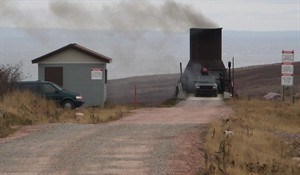
The incinerator in Old Perlican, N.L., since disabled, is shown Oct.23, 2008. The incinerator in Burgeo, N.L., is still spewing smoke four years after an originally promised phaseout but it's so decrepit the town will soon burn trash in an open pit. The Progressive Conservative government says 53 of the potentially toxic incinerators were used in 2001. THE CANADIAN PRESS/Tara Brautigam
March 23, 2013 - 1:00 AM
ST. JOHN'S, N.L. - The incinerator in Burgeo, N.L., is still spewing smoke four years after an originally promised phaseout but it's so decrepit the town will soon burn trash in an open pit.
"It's in bad shape," Mayor Gerald MacDonald said of the steel structure that's riddled with corrosion holes. "It's getting to be a dangerous situation.
"We don't want it to collapse on anybody, so it has got to come down."
Burgeo is one of seven tiny communities, most of them scattered along the same stretch of Newfoundland's gorgeous south coast, where incinerators burn on despite a provincial deadline to snuff them by the end of 2008.
The Progressive Conservative government says 53 of the potentially toxic ovens were used in 2001. It has since replaced the vast majority of them as part of a sweeping waste management strategy that has also closed scattered dumps in favour of regional, lined landfills and recycling depots.
But in small enclaves like Burgeo, built on the solid rock for which Newfoundland is famous, landfills aren't the most practical or affordable option. So in some cases, extensions were granted.
MacDonald said he would like to see his town's incinerator dismantled and the site cleaned up. In the meantime, the province has approved a permit for open-pit burning until a plan to truck garbage from the region to a new central landfill gets underway, he said. A transfer station has to be built where trash from about 1,450 Burgeo residents and nearby communities would be stored before it's hauled away.
"We've been after the government, you know, to move on with this."
The Burgeo site offers recycling for bottles, cans and some plastics along with a hazardous waste depot. Tires are not incinerated, MacDonald said. But there's little tracking of the household waste that goes in the incinerator and no equipment to monitor amounts of trash burned or emissions, he said.
A local contractor picks up residential garbage, he said.
"We never measure it, never weigh it. It's picked up by a local contractor and just dumped in."
Provincial inspectors visit a couple of times a year and have photographed the weakened structure, he added.
Municipal Affairs Minister Kevin O'Brien said the province hasn't set a new time frame for replacing its remaining incinerators. Isolated communities pose more challenges as officials search for the most affordable, sustainable solution, he explained.
"You can't dig a landfill anywhere. You know, Newfoundland and Labrador is called the Rock for a reason," he said in an interview. "So these are moving a little slower than what I would want it to be."
Cost is a growing issue as the province forecasts deficits totalling almost $4 billion over the next three years. Lower offshore oil production and a global economic slowdown have dramatically cut oil and mineral earnings.
Still, the province has overhauled waste management services and offers training to communities still using incinerators along with standards for what can and can't be burned, O'Brien said.
"There's health issues, there's your environment," he said of his commitment to further progress. "We've only got one world and we should be protecting it."
Statistics Canada's 2012 report "Human Activity and the Environment: Waste Management in Canada," says less than five per cent of municipal solid waste is incinerated across the country.
Burning trash reduces the amount of garbage to be disposed but "creates gaseous waste and ash and can contribute to air pollution," it says.
It describes how municipal incineration released 677 tonnes of particulate matter into the air in 2009.
Toxic dioxins and furans, persistent organic pollutants, "can result from incomplete combustion due to inadequate technology or improper incinerator operation," says the report.
Bob Houston, a resident of Kippens, N.L., said his community northwest of Burgeo used to feel the effects from an incinerator in nearby Stephenville before it was shut down in 2008.
"You could smell it in the night and in the mornings if there was no wind or if the wind was blowing this way. It was absolutely atrocious."
Houston said he used to turn off the air exchanger in his house when the fog-like fumes blew over.
The target for shutting down all incinerators has been a moving one but any further delay is "disgraceful," he said.
"The last time I drove into Burgeo the first thing that greeted me was the garbage, the smoke from it."
News from © The Canadian Press, 2013